
Peinture du camouflage en usine, à partir modification n°2107 du 19/01/1968 sur avion neuf ou révisé chez Dassault + chaine peinture pour 6 avions par mois a partir de janvier 68, pour 6 jours de travail en théorie (15 jours réel) sur une durée de 3 ans. Source : DTU Tome 2 page 81.
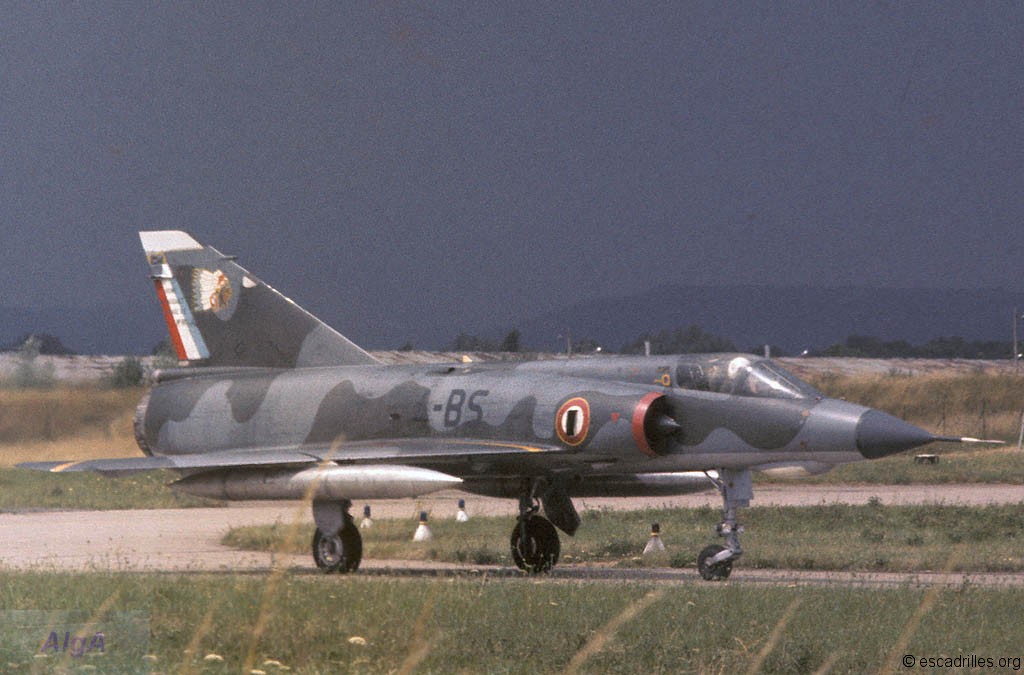
http://www.escadrilles.org/archives/3e-la-quatre/
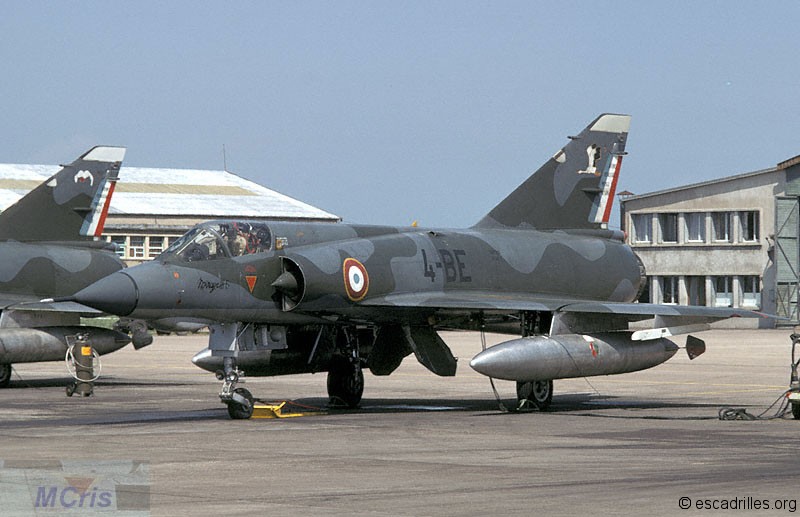

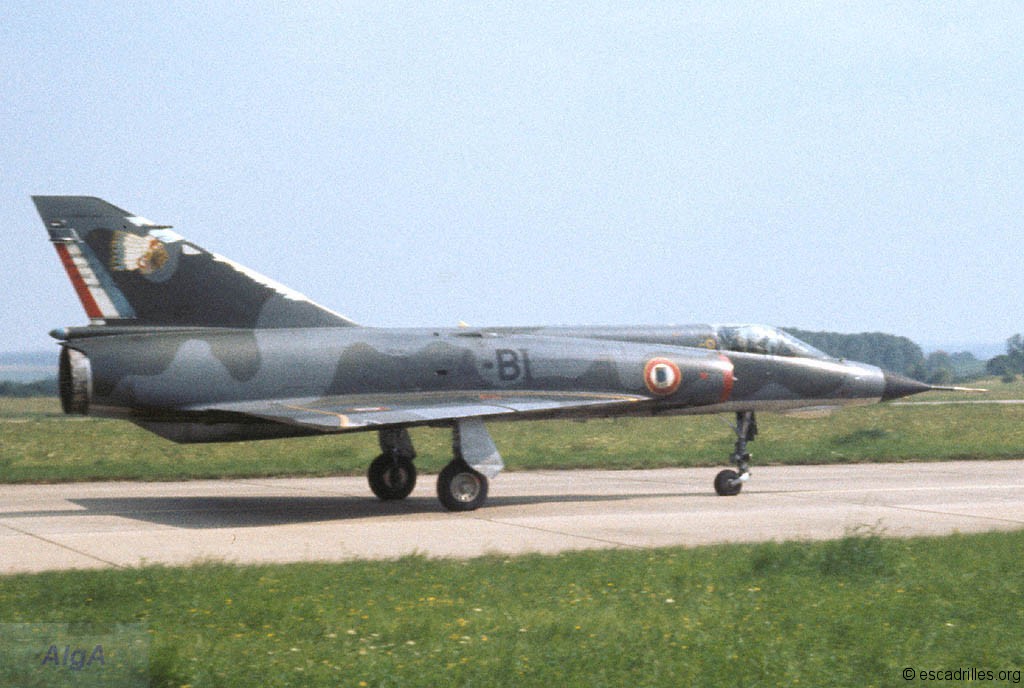

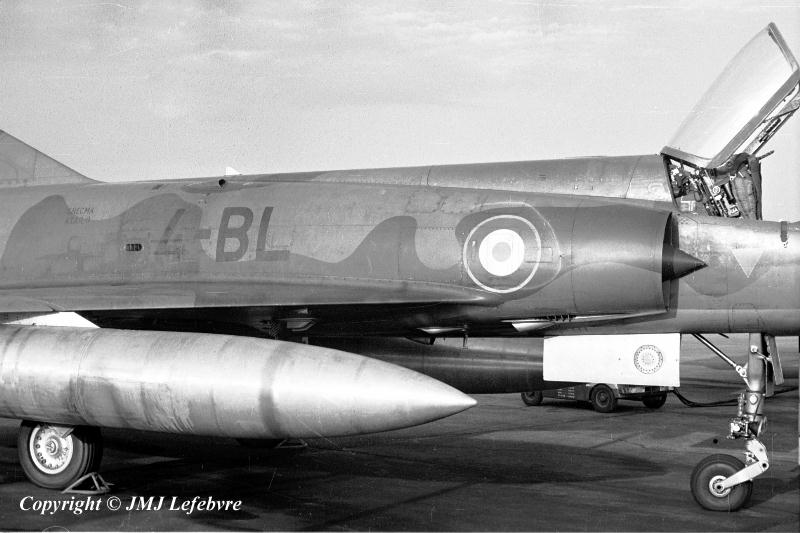
avion en alerte en bout de piste à Lure à coté de Luxeuil
Luxeuil AFB: 4ème Escadre de Chasse
- Night is not very far and first missions are ready to start. Here, navigation lights on, M III E 4-BN is about to have its engine started by pilot. Mechanic closely follows the whole procedure after having helped pilot to install next their common pre-flight external inspection.
- Last checks with the mechanic before engine ignition of another machine. East of France is cloudy for the evening and probably the ground mapping Cyrano II multi-mode radar allied to Doppler navigation radar have to be used for low penetration missions through the Vosges Mountains which are ideal because a very near and very few inhabited area for low level intensive training in all-weather conditions.
- All is Ok and BN taxies to take-off with three other aircraft for a night sortie.
- 4-BQ C/n 578 is following 4-BN. But what is intriguing for me is the curious thing in the grass. Roughly to be fun it seems a movie-lantern with film spools and an oblique lens to send pictures on passing clouds !!! I also hope it's not a WWII flack search-light or aircraft sound detector...!!!
- This man watching other EC 2/4 aircraft having to take-off for night flight sorties is the 'La Fayette' Squadron Leader, Commandant Rougevin-Baville. After having gained full flying unit experience, he entered later the War School and EPNER ( Flight Test and Reception Flying School ) to also qualify as military test pilot. So, around 1976 he flew the McDonnel Douglas F-15 at Edward AFB for a short evaluation of the type, an aircraft having received a French roundel from McDD to publicise the event. Colonel Rougevin probably was the sole AdlA pilot having flown the US type, except if later existed exchanges of fighter pilots between Mirage and F-15 squadrons.
- Commandant Rougevin-Baville during cockpit checking before complete installation and engine ignition. Mission coordinates were integrated by a pre-established data-card in the computer for a maximum of concentration to manage the military aspect of the flight. Thanks to Luxeuil based Radar Prediction Center's Mystère 20s reinforcing the navigation ability of pilots about to get the tactical nuke as primary mission devoted to 4th FW, they trained either by flying Mystère 20s in left seat with a Mirage III E environment or directly with Mirages in using the radar strip pictures established from scopes during definite tactical navigations done by the same Mystères. The all-weather penetration activities took the major part of the daily work of the two squadrons... (continues with next picture )
- Night is not very far and first missions are ready to start. Here, navigation lights on, M III E 4-BN is about to have its engine started by pilot. Mechanic closely follows the whole procedure after having helped pilot to install next their common pre-flight external inspection.
http://super-mystere.net/aar/planche/pages/34.htm
Luxeuil AFB: 4ème Escadre de Chasse
- EC 2/4 'La Fayette' squadron Mirage III E 4-BJ, C/n 536, was a little later replaced by brand new '617' and sold to Pakistan.
- The same 4-BJ, note that the fiber cone which closes the housing remains attached to the brake-chute.
- Between here...
- ...and here, 4 B-A, C/n 570, has lost its drag-chute. Note on the two views the ventral beam adapter without any bomb launcher either in fore or aft position. Adapter for AN-52 nuke bomb was a different one of this model.
- Mirage III E 4-AJ, C/n 521 which was later passed to 3rd FW and replaced by C/n 620. Thanks to front U/C door, 'Dauphiné' Squadron were easier to identify, fuselage codes being unvisible according light angles. Note the flatening fore wheel under brakes action. Some repair or modification had been executed on or around the UHF antenna on fin leading edge.
- Drag chute quits 4-AJ either due to a non intentional release by pilot or to an incident of fastener inside the chute housing. Note that the belly adapter beam is not very protuberent relatively to the rear queel.
- 4-AK has C/n 561 and is also fitted with the ventral beam, this indicating that bombing practice with AN-52 dummies was frequent during training to tactical nuke high speed and very low altitude penetration. This aircraft was written off on 22 December 1975.
http://super-mystere.net/aas/planche/pages/15.htm
Luxeuil AFB: 4ème Escadre de Chasse
- They go to target: a bit before his wingman, the section leader had the afterburner on to enter a steep climb while landing-gear began to retract. Note a lost drag chute on ground before normal release point.
- This unidentified 'La Fayette' III E lands with a little lateral balance effect. Indeed, left wheel had already touched and lifted a little when right hit the ground. I saw, on this same runway 30, a Thunderstreak with very wide track U/C and also a Mirage III C with a narrower going to grass and badly retracting their legs without speaking about incredible consequences which followed from Mirage !!!
This Mirage III E probably logs a good lot of hours: see leading edge of vertical fin to be convinced...
- 4-BT confirms the blind identification made with picture 26 which would have to be picture 27, but in the preparatory work, out of all precise identification task, I wanted to show something giving the logical sequence of a landing Mirage with the three pictures...
...and I also discover and rember that I asked to the two fighter pilots dispatched with me along runway in order to provide me all required explanations that they race with the squadron service Renault 4L car to be on parking in time to photograph arrival of the last landed aircraft. So, we end with Bravo Tango and his pilot...
- ...which aligns along ground marks by precisely following the mechanic's gestures... (In previous part I did a mistake about what is behind the square window at rear of ventral keel: the camera is an OMERA 60, and not a 40 which is a panoramic one fitted with a prism and installed on Jaguar and Mirage F-1 CR types )
- ...and leaves the latest aircraft received by squadron which he possibly flew for the first time...
- ...while mechanic continue close inspection of skin and systems before tanker arrive to refuel...
- ...and our BT pilot has joined his leader to form an almost perfect twin captain ground mirror formation if the latter was not giving precepts of their flight with left hand while the other holds a cigarette between right fingers...
http://super-mystere.net/aas/planche.htm
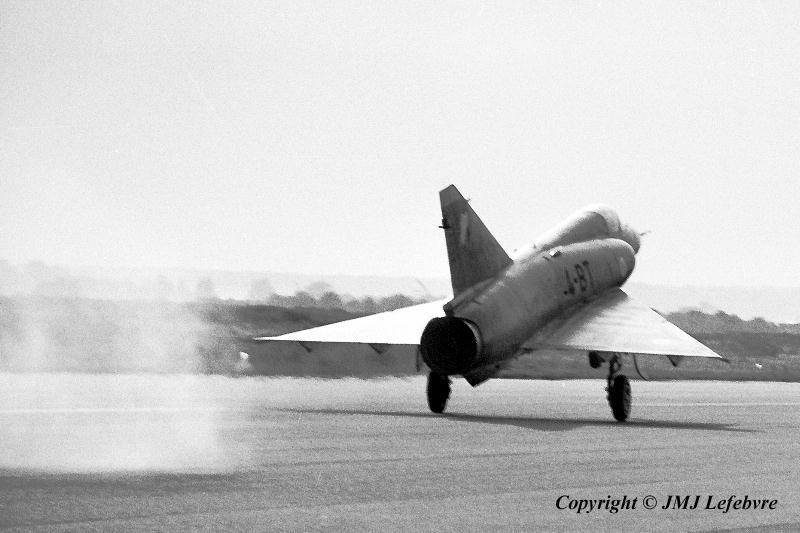
Luxeuil AFB: 4ème Escadre de Chasse
- 4-BM C/n 573... Sorry because the film scanner is not able to reproduce what is clearly visible on negative: the plate hanging under the nose anemometric probe indicates at top the coded aircraft configuration of aircraft " 6AXCEN " with below the mention " ARMED AIRCRAFT ".
Mechanics, don't play with the trigger, otherly...!!!
- Mirage III E coded 4-BL, probably C/n 514 or 564, is ready for flight with 1600 liters wing tanks. Other typical difference with aircraft of 'Dauphiné', the 'La Fayette' Mirages never had their last two registration letters, forming aircraft code, applied on the front door of the U/C nose leg.
- 4-BT under servicing before next flight. Note the slightly extended wing combat brake under the 4 cipher.
- 4-BH C/n 504 and its large external tanks is ready for next mission, a night flight navigation with some points to attack. Unvisible here, its belly adapter beam was installed. Formerly this machine flew as 13-QQ, 3-IK and 2-LL. Was probably about to be replaced by C/n 568.
- C/n is 585 for F-ULBN coded 4-BN. Being about to be officially a nuke Wing, older aircraft of 4th FW were progressively exchanged and almost all, if not all, III Es in inventory ended to be in the 560 to 625 block otherly said in the last 65 built for Armée de l'Air on a total of 265 ordered.
- This next view shows that all was again normal except the large white trail on the ground...
Fore Mirage 4-BQ is C/n 578 and had been, a little before, 4-BE. This latter 4-BE having been replaced by C/n 590 which, successively, had already been 3-IG and 4-AM.
http://super-mystere.net/aar/planche/pages/28.htm
Luxeuil AFB: 4ème Escadre de Chasse
- Between a towing bar and mobile nitrogen supply, the military aviation version of Kärcher... to clean either dirty part of aircraft or various kerozen or hydraulic leaks left on the ground... Similar devices are used at the Cazaux air base to wash salted aircraft after gunnery sorties low over the sea. Behind, without no man's land, the unvisible border between aircraft of 'La Fayette' and 'Dauphiné' squadrons.
- Under hot sun and air of early August 1972, Mirage III E C/n 573 is ready for next flight in clean configuration. Under belly, a pipe to drain hydraulic liquid.
- 4-BT '614' the then only Mirage III E of EC 1/4 delivered with the new standard of rudder deprived of tricolor flag, is about to take-off for an air combat mission with clean configuration to fly over Mach 2. Note the awaiting 30mm ammunitions often used during one or other phases of the different typical types of training missions for some straffing pass over existing firing ranges located in France or in neighbouring NATO countries. Alert 4th FW aircraft in dispersion areas carried true ammunitions from 30mm shells to nuclear tactical AN-52 bombs which were introduced in the Wing during 1972, 4th being the first tactical nuke unit instaured inside Armée de l'Air, the second, after Jaguar introduction, being 7h FW of Saint-Dizier.
-The opposite side of picture 14. Pilot and mechanic going to aircraft as a single man... You have a look on nitrogen bottles inside the tow placed before the "Kärcher' mobile cleaning device. Background, hiding the Dewoitine 520, the protruding cap of the underground commanding post with rear, the main Base and Wing Commanding Post linked to control tower, a place I knew quite well during the first four months of 1963 to wait, inside or around ambulance, a possible crash and bring first medical assistance if necessary. I saw just two among hundreds and hundreds of F and RF-84Fs taking-off or landing and, halas for you, I have no photographs, just a 8mm movie film...
At mid distance, Max Holste MH-152 Broussard 4-WZ belongs to Blind Flying and Liaison Section of 4th FW and the Centre Est DR-300 2+2, partially hidden , is the aircraft with which a chap of mine, having had an original idea, went to see me during my report among combat aircraft !!
They are passing 4-BS which is fitted with supersonic wing tanks and the long ventral adapter beam carrying itself, rear, a short bomb rack destined to receive small exercise or active bombs but here, very probably, the 'bombette' having all ballistic characteristics of the nuclear tactical AN-52 bomb.
- 4-BT, C/n 615, is now beginning to taxy thanks to a short burst of thrust...
- While another Mirage begins to taxi, another pilot is joining his fi ghter while another has its port wing tank under refuelling.
http://super-mystere.net/aar/planche/pages/14.htm
Luxeuil AFB: 4ème Escadre de Chasse
- Applied on the bottom wall of EC 2/4 'La Fayette' hangar, the Mirage tail which never was included a two part arrow, each part probably being at the colour of each corresponding escadrille (again sorry to have not my slides). Here the escadrilles hierarchy is respected with N 124 first and SPA 167 second. See 4th FW Part one about what was said concerning inverted position of Sioux and Stork insigna on fin sides.
- Also in 'La Fayette' hangar painted beside the previous picture, the EC 1/4 'Dauphiné' side in a similary two part arrow. Greyhound of SPA 81 and Condor of SPA 37.
This is interesting because the squadron marks on right and left fin being opposed side by side on this wall may let think that each Mirage III E of 4th Wing could receive marks of both squadrons. I do such a speculation because I never saw two squadrons of a same wing having the same fin graphic general arrangement to contain their insigna and, moreover, I never saw a particular squadron in a wing having together on each fin side its two escadrille emblems.
This project for EC 1/4 might have something schocking to be adopted: the Greyhound belonged to second escadrille and Condor to the first and this latter had to be into the leading arrow... But, sincerely, was it possible for a Greyhound to be pursued by such an agressive Condor? No, each distinguished animal of 'Dauphiné' had to live on a fin side and so prevent squadron with intestine wars ! The same for 'La Fayette' because their Sioux considered and always consider their Stork comrades only as ducks...
Ha Ha, with such a mixture on each aircraft the wing risked to lose its whole feathers...!!!
http://super-mystere.net/aar/planche/pages/05.htm
Luxeuil AFB: 4ème Escadre de Chasse
- General view of fin of Mirage III E coded 4-BM. Before affectation to 4th FW, this aircraft flew with CEV (Flight Test Center) probably to qualify some modification or new device introduced during production deliveries. Under rudder and mid conical case of brake-chute system, the outlet to evacuate hot air from rear extremity of the internal thermal shield, just before the actuators of variable section nozzle. The shield extended around the afterburner duct under the skin of fuselage. Just before Sioux nose the UHF antenna location; the VHF one being at top of fin.
- If you refer to tail of C/n 614 seen later, you see several differences. First is that no one III E of 'La Fayette' Squadron is wearing the large C/n ciphers generally applied on Mirage III fins. Secondly, this led to paint, when EC 2/4 were already based at Luxeuil, the C/n number on rudder ( you don't find it on flagless rudder of 'Dauphiné' Squadron aircraft) with a different black paint. Also note on previous picture the lack of dot between M and Dassault...
- Greyhound side of C/n 614 coded 4-AD. About the 225 Mirage III Es built for Arméee de l'Air, after '614' and '615', 4th FW had to receive 8 other brand new aircraft, the last two production machines being alloted to 3rd FW but went to 4th after having spent months with the Nancy based Wing.
http://super-mystere.net/aar/planche.htm
Luxeuil AFB: 4ème Escadre de Chasse
- Mirage III Es of EC 2/4 'La Fayette' introduced something completely wrong!!! Indeed, SPA 124 and its Sioux head always was considered as 1st escadrille of the squadron and, traditionally, its badge had to be applied on left side of aircraft. Here, this has been broken and just have an eye on the following picture to be convinced.
Here, opened to sights, the brain materials of Mirage III E. Declined from C model for interception, the E type was due for assaut missions. Playing with words, it surely was an "Avion Dassault" !
For this the fore part of fuselage was elongated by 30cm, about 1ft, to include more avionics in the bay behind cockpit. Radar was now a multi-mode Cyrano II of Thomson Csf. Engine was the more powerful C3 version of the ATAR 9 and the aircraft, as Mirage III C, could receive the rocket-engine SEPR 841. Total load of 4400 kgs could be carried under five ventral and wing pylons.
- Always the same walking officer and the other side of 4-BP, C/n 476, wearing the "Duck" of SPA 167. Sioux pilots never missed their chaps of 2nd escadrille when they did something wrong. Your are just "ducks". This was appreciated with forced smiles by the champions of a pure 'Stork' traditional escadrille.
Moreover major electronics, the rear bay contained oxygen bottles and a tank for inverted flight. Note the nose cone adding metal and composite structures to respectively cover electronics and parabolic antenna of the Cyrano multi-mode radar.
http://super-mystere.net/aaq/planche/pages/28.htm
Le Mirage IIIE ( 615, 4-BT ) du 2/4 " La Fayette " exposé sur la BA 116 de Luxeuil en mai 1975. Photo : Michel Debarre.
ACCUEIL | ME CONTACTER | LIENS